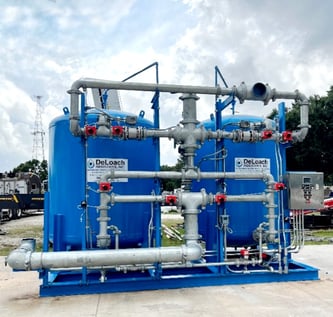 If you’ve been following the news, you know a growing problem with PFAS (per- and poly-fluoroalkyl substances) exists.
If you’ve been following the news, you know a growing problem with PFAS (per- and poly-fluoroalkyl substances) exists.
PFAS, a group of synthetic chemicals in a wide range of products, is causing a growing concern. Despite their widespread use, some PFAS compounds have been found to degrade into potentially harmful byproducts like PFAS-methyl tetrahydrofuran. What's more alarming is that these chemicals have infiltrated our drinking water sources, even in areas with high water tables. This is why it's crucial to understand effective methods for removing PFAS from water. What should you do if you suspect that there’s a problem with your water? Check the source of the water, test it, and treat it if necessary.
Follow these steps to remove PFAS from drinking water.
Test Your Water
Although knowing how to remove contaminants is essential, it’s even more important to understand how to test your water for contamination. A water test kit can help you determine whether there are contaminants in your water and whether they are at a dangerous level. You can purchase water test kits at grocery stores, hardware stores, and online retailers. Generally, these kits come with the standard set of tests for a home water filtration system, but they also often include tests for specific contaminants. Use these tests to determine whether your water is safe to drink. If your water contains contaminants, remove them from your water source. This can be done by digging a more bottomless well, installing a water filtration system, or getting a water purification system. If your water does not contain contaminants, you don’t need to do anything except continue drinking your water.
Check the Source
Understanding the source of your water is a crucial step in addressing contamination. Whether you have a well or a water treatment system, knowing where your water comes from can provide valuable insights. By tracing the water's journey from the source, you can determine if contamination occurs upstream. This knowledge is essential for well owners, who might overlook the significance of understanding their water source. If you find contamination at the source, you can address it immediately, such as reducing the distance between the source and your dwelling or seeking alternative, uncontaminated sources.
Give Your Well a Cleanup
If your well is contaminated, you must ensure it is not the source of water contamination. If your well is contaminated, you may consider digging a more bottomless well, installing a water filtration system, or getting a water purification system. You can also try cleaning your water source. A surprising amount of contamination comes from the source. For example, farmers often put fertilizer near their wells, which is a much cleaner option than spraying it on your lawn. Unfortunately, the fertilizer may end up near the well and in your water. There are many water treatment products that you can use to clean your sources, such as RO filters and water filters.
Get a Water Filter
Installing water filters tailored to your needs proves effective for uncontaminated water sources requiring selective contaminant removal. Various filter types cater to specific contaminants, ensuring comprehensive purification. Categories like carbon filters for odor and sediment removal, sediment filters for more significant impurities, micron filters for size reduction, and ultraviolet filters for microbial elimination offer versatile solutions to enhance water quality.
- Carbon filters can remove sediment and odors, generally used to provide good-tasting water.
- Sediment filters can remove large amounts of sediment and other impurities from the water and are generally used to provide good water quality for drinking.
- Micron filters reduce contaminants' size and are generally used to provide good drinking water quality.
- Ultraviolet filters can kill bacteria and viruses in the water and are generally used to provide good water quality for drinking.
Get a Reverse Osmosis System
If your source is contaminated, but your water is not, you can get a reverse osmosis (RO) system to purify your water. A RO system filters water from a source, removing many contaminants and providing clean, safe drinking water. There are many types of RO systems, and you can choose the one that best suits your needs. Some of the most common types of RO systems include Under and above-ground RO systems. These systems can be installed under your house or well, and gravity can draw groundwater into the system.
- Point-of-use systems: These systems can be installed under your sink. A faucet pulls water from your source into the system.
- Backwash systems: These systems can be installed in a house or commercial facility. They use water to wash dishes or clean carpets and power the system.
Summary
If your water is contaminated, you can test for contaminants and remove them through a water filter, water treatment system, water distiller, or water purification system. Generally, these systems use a combination of filtration, treatment, and disinfection to ensure your water is as clean as possible. You can also install a water meter to find your water source and dig a deeper well if necessary. If you discover contaminants in your well, install a water filter or distiller or call the professionals at DeLoach Industries at 941.371.4995 to assist you in obtaining the purest and highest quality drinking water at home.




